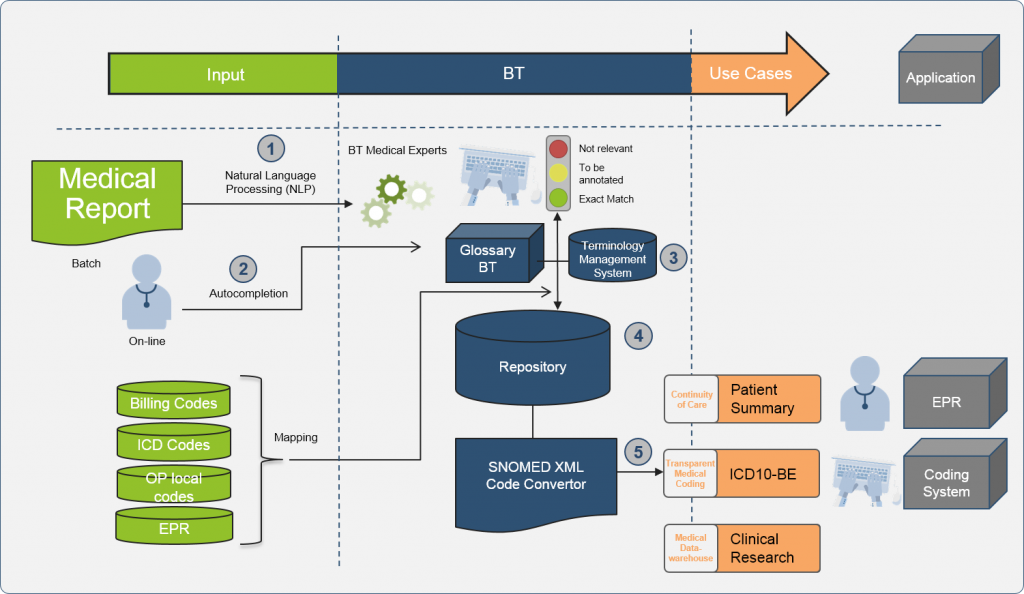Products

The parser of BT Clinical Computing parses text and links the text to the SNOMED CT dictionary rendering text intelligent. The parser will keep the combined concepts together (nesting) and will split pre-coordinated concepts in his components based on the Snomed definitions to guarantee the equivalence between pre- and post-coordinated coding. Parsing can be done in batch creating a SNOMED CT repository of SNOMED CT-indexed text.
In a BT Webapplication text can be pasted and the parsing Webservice will show the resulting SNOMED CT codes and help users to find secondary codes like ICD or other.
The parsing Webservice allows the instant extraction of coded information from text in the medical record. This means that any report or memo can be stored as plain text with intelligent behaviour behind. This eliminates the need of ‘code’ fields in the data structure of the medical record.
Data and text entry in the medical record and in medical reports is supported by a SNOMED CT dictionary with a Autocompletion function and Flow chart guidance. The SNOMED CT-Interface allows a fast and intuitive coding in the electronic medical record. It can be integrated as a terminology component in the existing Patient summary of the EPR and in any medical report.
The Autocompletion is Smartphone-like: the terms are presented as you type. Missing terms can be added to the vocabulary. Personal terms and acronyms can be used and added. The vocabulary grows as you use it and the search will be tuned to the user or specialty.
Context sensitive pick lists or flow chart guided protocolling systems can be created for specific situations (secondary coding, registries, clinical pathways, studies). The ICD-mode offers check boxes for the attributes needed for ICD-coding and pops up the qualifiers in local language which are concatenated to a full sentence.
Controlled terms from the vocabulary are combined with free text in a transparent way. The controlled terms are always Snomed-compliant. A typical use of flow chart guidance is the medical protocol for technical procedures (endoscopy, imaging) and surgery. The protocolling schemes are linked to the codes of the Resource Management System and offer semi-automatic text-generation with control of all needed attributes and resulting in the right ICD and national reimbursement codes. Home medication can be entered using a wizard with the strength, formulation, default dosage, route and duration. Since the medication is Snomed-coded, the home medication can be converted to the hospital medication in an automatic way and vice versa.
The terminology management system and Snomed browser of Indizen is widely used by hospitals and several ministries.
The IT server is connected to the Snomed coding system to make cross maps between the local terminology and SNOMED CT.
The Webservices of Indizen are used for the Autocompletion and Flow chart guidance. In the terminology management system health care professionals and departments can easily create their own schemes and terminology, always based on SNOMED CT. Medical terms can be added or the SNOMED CT-definition can be corrected in a Cloud environment so that all users benefit of the common terminology work.
A local clinical data warehouse is organised from the SNOMED CT coded text and data with the most modern data retrieval technology for big data.
The data can be accessed in a distributed way on the different databases in the hospitals even from different countries.
Data access is governed by the hospitals themselves. Data queries and analyses can be done after approval of the study protocol.
The study protocol specifies the objective, the data analysed, the type of analysis, the degree of aggregation.
Standard queries can be developed for
- Safety and efficacy of drugs, procedures, devices,…
- Epidemiology
- Key Performance Indicators, benchmarking
- Socio-economic studies
- Simulating models for hospital financing
The functionality of the Snomed-coded Patient Summary for clinical trial management, studies on drug use and pharmacosurveillance can be contracted to the pharmaceutical industry for the hospitals which give their consent for their data.
Data querying uses Snomed Refsets for grouping.
Queries should control for pre- and post-coordinated expressions using the Snomed definitions of pre-coordinated concepts.
The use of different Snomed attributes (body structure, surgical access, access device …) makes analyses possible along different axes.
Historical hospital data in ICD-9-CM or ICD-10 can be converted to Snomed CT and will be used for trend analyses.
A smart code convertor converts the Snomed codes combined with metadata (start- and stop dates) to ICD, reimbursement codes of procedures, registries, ICPC, UpToDateR, drug surveillance … based on given cross maps and conversion rules. This means that no or a minimum of manual coding is further needed.
The code convertor includes the conversion to ICD-9-CM, ICD-10 and ICD-10-CM/PCS based on the cross maps and rules of BT Clinical Computing integrating the cross maps of the NLM.
With the terminology management system the hospital can create or change the cross maps and rules for conversion to their local codes.
From the SNOMED CT-coded data, a Summary of the patient record can be extracted giving the overview of the essential data of the patient (diagnoses, procedures, medication, vaccinations) for the Health Care Professional (Patient Summary) or patient (Personal Health record).
The coded Patient Summary is the intelligent cockpit of the medical record and can be exchanged with different applications in and outside the hospital. It is connected with EBM decision support (UpToDate, drug surveillance).
Data can be anonymized and exchanged electronically for registries and clinical trials.
